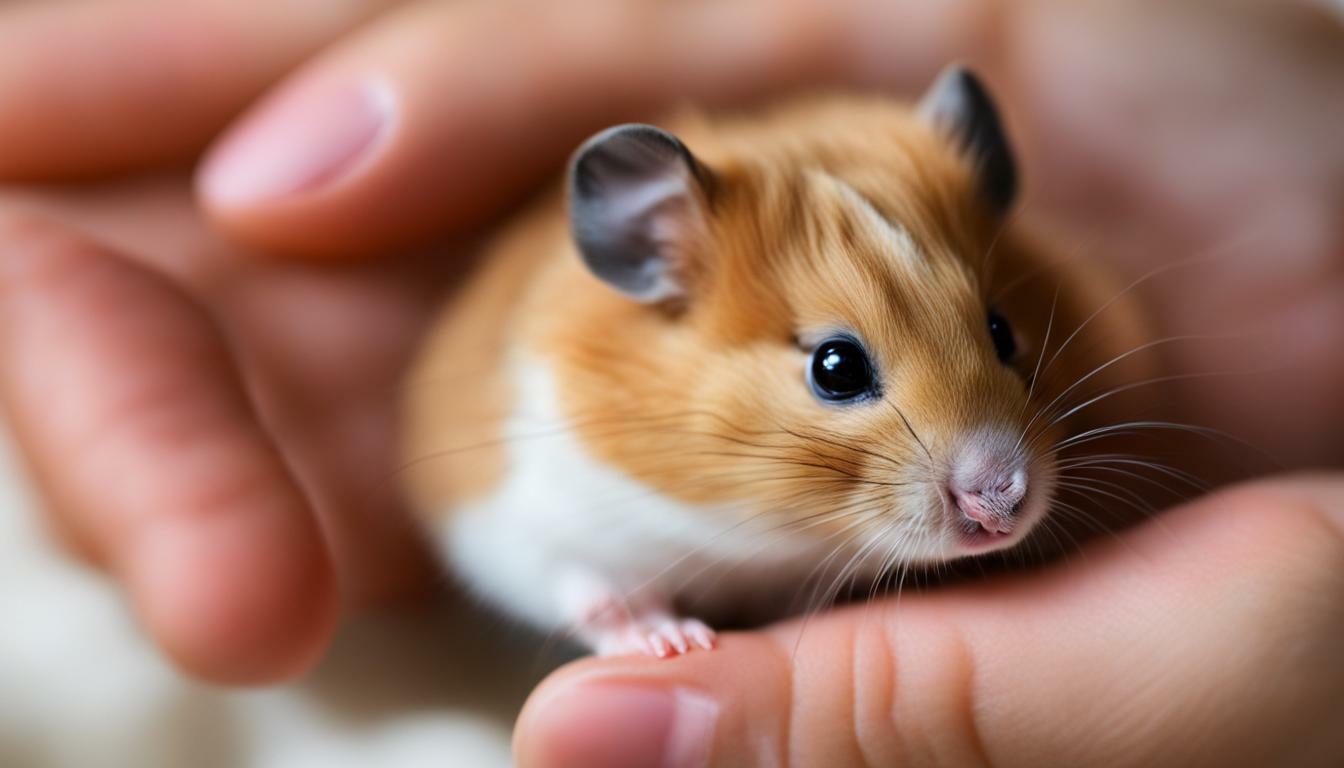Many people wonder, “Do hamsters like to be pet?” Hamsters generally enjoy being petted, but it’s important to know how and when to pet them. Like humans, hamsters have specific preferences when it comes to touch. To ensure a positive experience for both you and your furry friend, it’s important to understand their petting preferences.
Key Takeaways:
- Hamsters generally enjoy being petted, but it’s important to know their preferences.
- The proper way to pet a hamster is to cup them in the cradle of your hand and use light strokes down their back.
- Signs that a hamster enjoys being petted include chirping, relaxed facial features, and a relaxed body posture.
- Not all hamsters like to be petted, and it’s important to respect their boundaries.
- When introducing a new hamster to petting, take it slow and be patient in building trust and a bond with them.
Understanding Hamster Behavior and Body Language
To know if your hamster enjoys being petted, it’s important to understand their behavior and body language. Hamsters, like humans, have their own preferences when it comes to interaction and bonding. By observing their behavior and paying attention to their body language, you can better gauge their comfort level and ensure a positive experience for both you and your furry friend.
When a hamster is relaxed and open to interaction, they may display certain behaviors that indicate their enjoyment. For example, they may chirp or make soft noises, which is a sign of contentment. You may also notice that their facial features appear more relaxed, with their eyes and ears in a natural position. A relaxed body posture, with their back straight and not hunched, is another indication that they are receptive to being petted.
On the other hand, if a hamster does not enjoy being petted, they may exhibit signs of discomfort. They may hiss, bite, or try to run away when approached. These behaviors indicate that they want to be left alone and their boundaries should be respected. It’s important to understand that not all hamsters have the same preferences, and each individual may have varying levels of tolerance for petting and interaction.
When introducing a new hamster to the concept of petting, it’s crucial to take it slow and allow them to become comfortable at their own pace. Building trust and a bond with your hamster takes time and patience, so avoid rushing the process. Slowly approach your hamster, allowing them to sniff your hand and get used to your presence. Offer treats as a positive reinforcement, associating your touch with something rewarding. By taking these steps, you can create a positive environment for petting and interaction, ensuring a strong bond with your hamster.
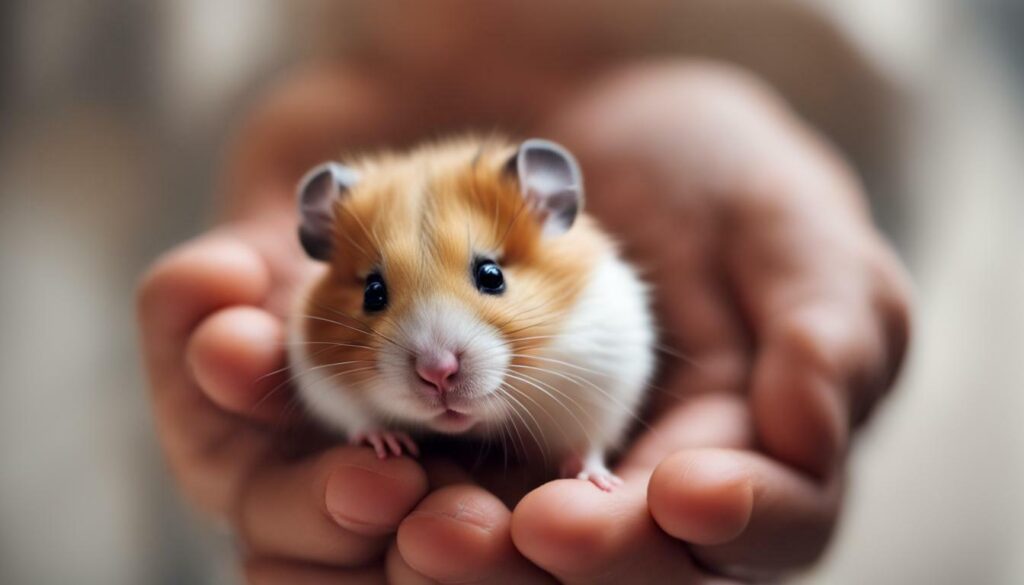
| Signs of Enjoyment: | Signs of Discomfort: |
|---|---|
| – Chirping or soft noises | – Hissing |
| – Relaxed facial features | – Biting |
| – Relaxed body posture | – Trying to run away |
Remember, each hamster is unique and may have different preferences. It’s essential to respect their boundaries and adjust your interactions accordingly. Building a trusting bond with your hamster through understanding their behavior and body language is key to a positive petting experience.
Proper Technique for Petting a Hamster
Petting a hamster requires knowing the proper technique to make them feel safe and relaxed. Hamsters, like humans, have their preferences when it comes to physical interaction. By following these guidelines, you can ensure a positive and enjoyable experience for both you and your furry friend.
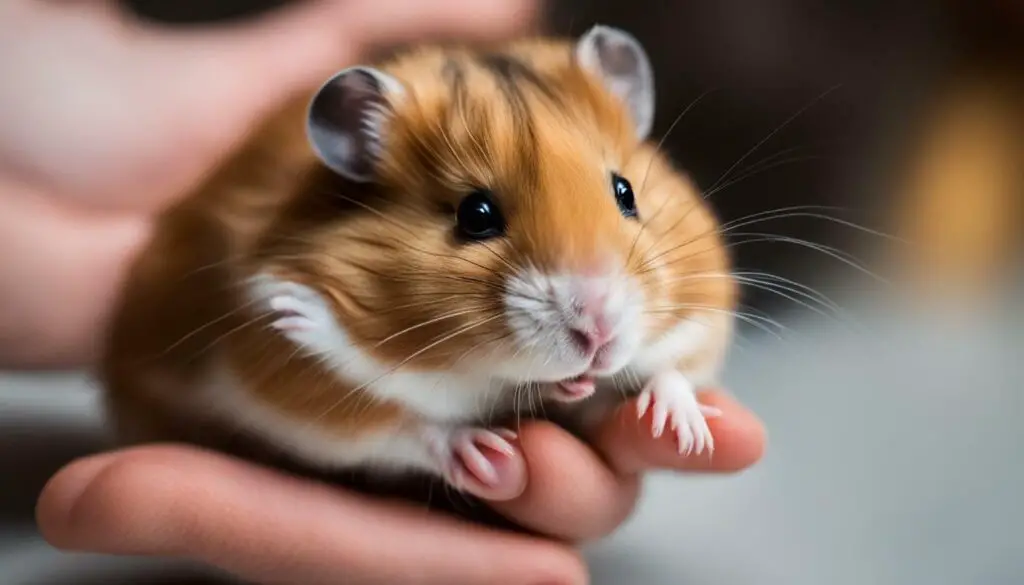
First, it’s important to approach your hamster slowly and gently. Let them sniff your hand and become comfortable with your presence. Once they show signs of relaxation, you can proceed to pick them up and hold them in the cradle of your hand.
When petting a hamster, use light strokes along their back with your fingers. Avoid touching their head or belly, as these areas can be sensitive. Pay close attention to their body language to gauge their response. If they seem tense or try to move away, it’s a sign that they may not be enjoying the petting, and it’s best to stop and give them some space.
Remember, each hamster is unique, and their preferences may vary. Some hamsters may enjoy longer petting sessions, while others may prefer shorter interactions. It’s important to respect their boundaries and adjust your approach accordingly. By observing their behavior and listening to their cues, you can create a positive and mutually beneficial bond with your pet hamster.
Signs that a Hamster Enjoys Being Petted
Paying attention to certain signs can tell you if your hamster is enjoying the petting experience. Hamsters are known to be sociable and can form bonds with their owners through gentle interaction, including petting. When you approach your hamster, observe their body language and behavior to gauge their response. Look for these signs to determine if your hamster is enjoying being petted:
- Chirping: Hamsters may emit a soft chirping sound when they are content and relaxed. If you hear this sound while petting your hamster, it’s a good sign that they are enjoying the interaction.
- Relaxed facial features: Watch for signs of relaxation in your hamster’s face. If their eyes are half-closed, their whiskers are relaxed, and their mouth is slightly open, it indicates that they are comfortable and enjoying the petting.
- Relaxed body posture: A hamster that is enjoying being petted will have a calm and relaxed body. They may stretch out, lie down, or lean into your hand as you stroke them.
Remember that each hamster has their own unique personality and preferences, so it’s important to pay attention to their individual cues. Some hamsters might show their enjoyment more subtly, while others may be more vocal and expressive. Take the time to understand your hamster’s preferences and adapt accordingly.
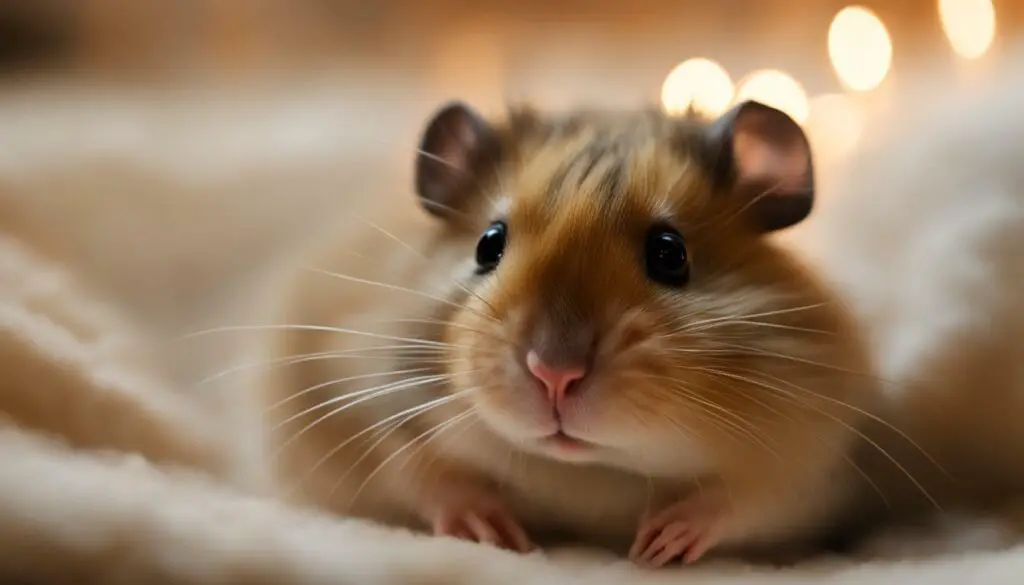
| Signs that a Hamster Enjoys Being Petted | Signs that a Hamster Does Not Like Being Petted |
|---|---|
|
|
While petting your hamster, it’s crucial to approach them gently and with respect. Avoid sudden movements or loud noises that can startle them. Always start by offering your hand for them to sniff and investigate before attempting to pet them. If your hamster shows signs of discomfort, such as frozen or tense body posture, it’s important to immediately stop the interaction and give them space.
Creating a positive and enjoyable petting experience helps strengthen the bond between you and your hamster. Regular interaction and petting provide mental stimulation and can contribute to your hamster’s overall well-being. By understanding your hamster’s preferences and respecting their boundaries, you can ensure a harmonious and enjoyable relationship.
Signs that a Hamster Does Not Like Being Petted
It’s crucial to recognize the signs that indicate your hamster is not enjoying the petting session. While some hamsters enjoy being petted, others may find it uncomfortable or stressful. Being aware of their preferences is essential to ensure their well-being and maintain a positive relationship. Here are some signs to look out for:
- Hissing or growling: If your hamster starts hissing or growling when you try to pet them, it’s a clear indication that they are not enjoying the interaction. This defensive behavior suggests that they feel threatened or uncomfortable, and it’s important to respect their boundaries.
- Biting: Biting is another sign that your hamster is unhappy or stressed during petting. If they nip or bite your hand, it’s best to immediately stop petting and give them space. Continuing to pet them in this situation can escalate their fear and result in further aggression.
- Running away or hiding: If your hamster tries to escape or hides when you approach them for petting, it’s a clear signal that they are not interested or comfortable with the interaction. Respect their desire for privacy and avoid forcing them into unwanted contact.
It’s important to remember that each hamster has its own unique personality and preferences. While some may enjoy being petted, others may prefer minimal physical contact. Understanding and respecting your hamster’s boundaries is crucial for building trust and maintaining a positive relationship.
Hamster Petting Preferences:
| Signs That Indicate Enjoyment | Signs That Indicate Discomfort |
|---|---|
| Chirping | Hissing or growling |
| Relaxed facial features | Biting |
| Relaxed body posture | Running away or hiding |
Remember, building a positive bond with your hamster takes time and patience. It’s important to observe their behavior and adjust your approach accordingly. If your hamster doesn’t enjoy being petted, focus on other ways to interact and bond with them, such as providing enriching toys, treats, and supervised playtime outside of their enclosure. By understanding and respecting their preferences, you can create a harmonious and enjoyable relationship with your furry friend.
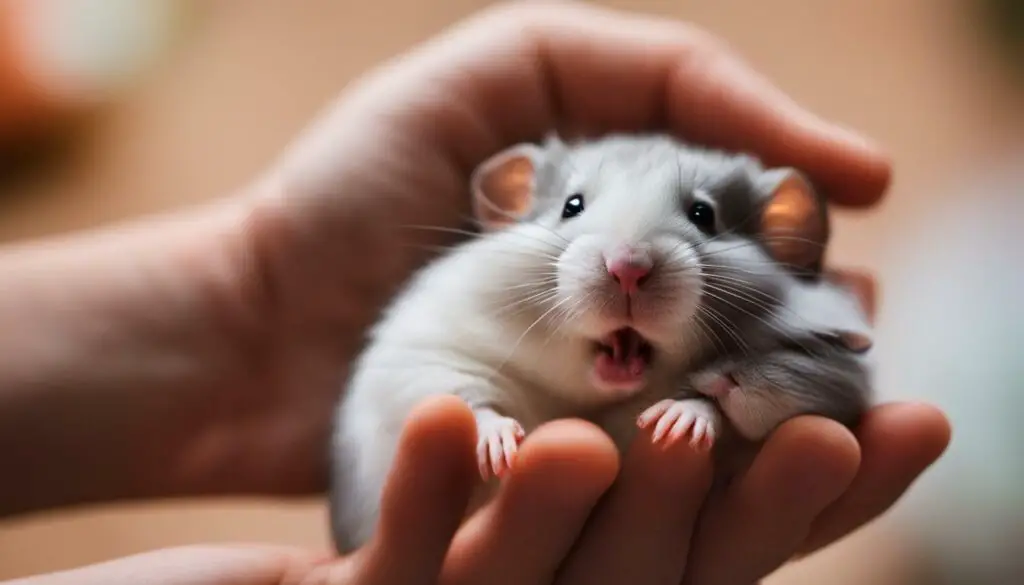
When bringing a new hamster home, it’s essential to introduce them to the idea of being petted gradually. This will help them feel comfortable and build trust in their new environment. Start by allowing them to acclimate to their cage and surroundings for a few days before attempting any interaction.
Once your hamster seems settled, you can begin by offering them treats from your hand. This allows them to associate your presence with something positive and creates a foundation for trust. Use gentle movements and avoid sudden gestures that may startle them.
As your hamster becomes more comfortable, you can try introducing light petting. Cup your hand and let them explore your palm at their own pace. Avoid touching their head or tail initially, as these areas can be sensitive. Instead, focus on gently stroking their back with soft, slow movements.
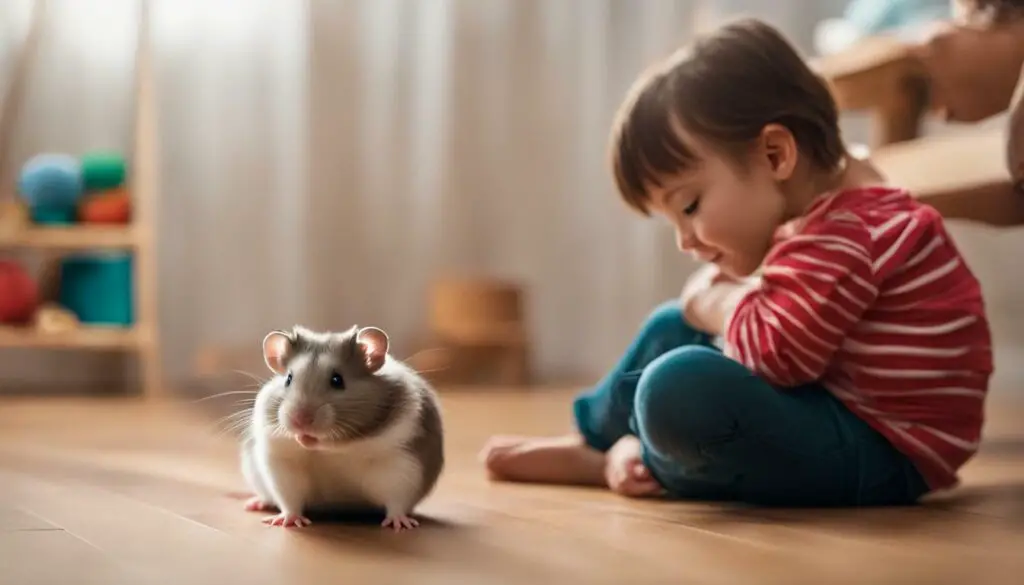
Remember, every hamster is unique and may have different preferences when it comes to petting. Some may enjoy longer strokes, while others may prefer shorter, lighter touches. Observe their body language and listen for any vocalizations they may make, as these can indicate their level of comfort and enjoyment.
| Signs That a Hamster Enjoys Being Petted: | Signs That a Hamster Does Not Like Being Petted: |
|---|---|
|
|
Building Trust and a Bond with Your Hamster
Building a strong bond with your hamster takes time and patience. It’s important to allow them to set the pace and not force any interactions. Spend time near their cage, talk softly to them, and offer treats regularly. This will help them associate you with positive experiences.
Gradually increase the duration and intensity of your interactions as your hamster becomes more comfortable. Remember to always approach them calmly and avoid sudden movements. With consistent effort, you can create a trusting relationship with your furry friend, making each petting session an enjoyable experience for both of you.
Building Trust and a Bond with Your Hamster
Building trust and a strong bond is key to ensuring your hamster feels comfortable and enjoys being petted. Hamsters are delicate creatures that rely on trust to form relationships with their owners. By understanding their individual preferences and providing a positive environment, you can establish a strong bond with your hamster.
To begin building trust, start by allowing your hamster to become familiar with your presence. Spend time near their cage, talking softly and offering them treats. This will help them associate your presence with positive experiences. Gradually, you can start using your hand to offer treats and allow them to sniff and explore without feeling threatened.
Once your hamster is comfortable with your hand, you can begin the process of petting. Cup your hamster in the cradle of your hand and use light strokes along their back. Pay attention to their body language and vocalizations. If they chirp and exhibit relaxed facial features and posture, it’s a sign that they enjoy the petting.
Remember, each hamster is unique and may have different levels of tolerance for petting. Some hamsters may prefer shorter petting sessions, while others may enjoy longer interactions. It’s important to respect their boundaries and not force any interaction upon them if they show signs of discomfort or unease.
| Signs that a Hamster Enjoys Being Petted: |
|---|
| – Chirping |
| – Relaxed facial features |
| – Relaxed body posture |
Remember, building trust and a bond with your hamster takes time and patience. It’s important to approach interactions with love and respect for your hamster’s individual preferences. By providing a positive and enjoyable petting experience, you can strengthen your bond and create a lasting relationship with your furry friend.
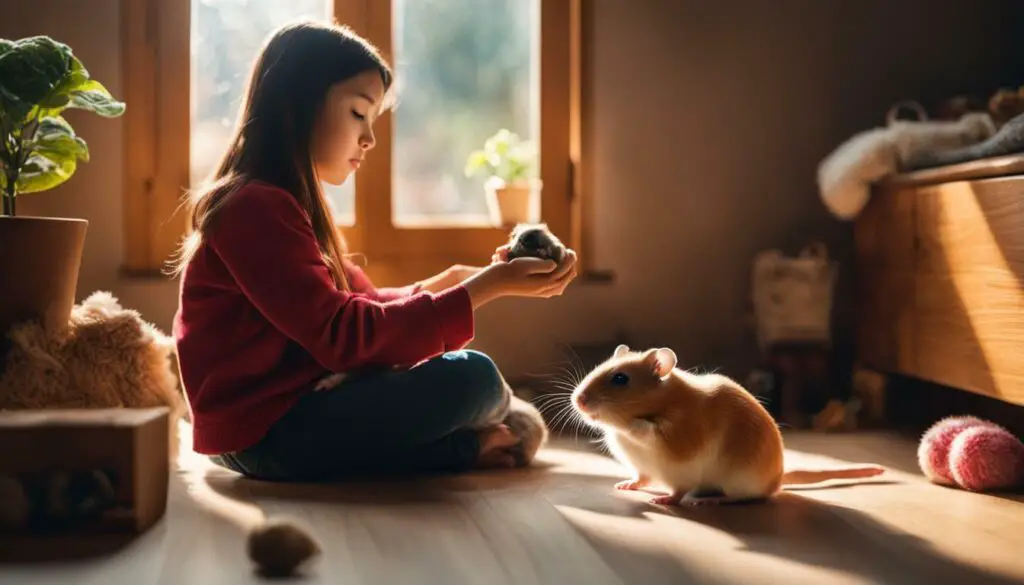
It’s important to recognize that each hamster has their own individual preferences when it comes to petting. Just like humans, hamsters have unique personalities and comfort levels when it comes to physical interaction. Some hamsters may enjoy being petted and crave attention, while others may prefer to be left alone or have limited interaction.
When trying to determine your hamster’s petting preferences, it’s essential to pay close attention to their behavior and body language. Observe how they react when you approach their cage or try to interact with them. Are they curious, calm, or do they become anxious and try to retreat? Understanding these cues will help you establish a positive and respectful bond with your furry friend.
To ensure a positive petting experience, it’s crucial to approach your hamster with gentle and calm energy. Start by offering your hand near them and observe their response. If they show interest and approach your hand willingly, it’s a good sign that they may enjoy being petted. Remember to use light strokes and avoid any sudden movements that could startle them. It’s also important to focus on petting their back and avoiding sensitive areas, such as their face or tail.
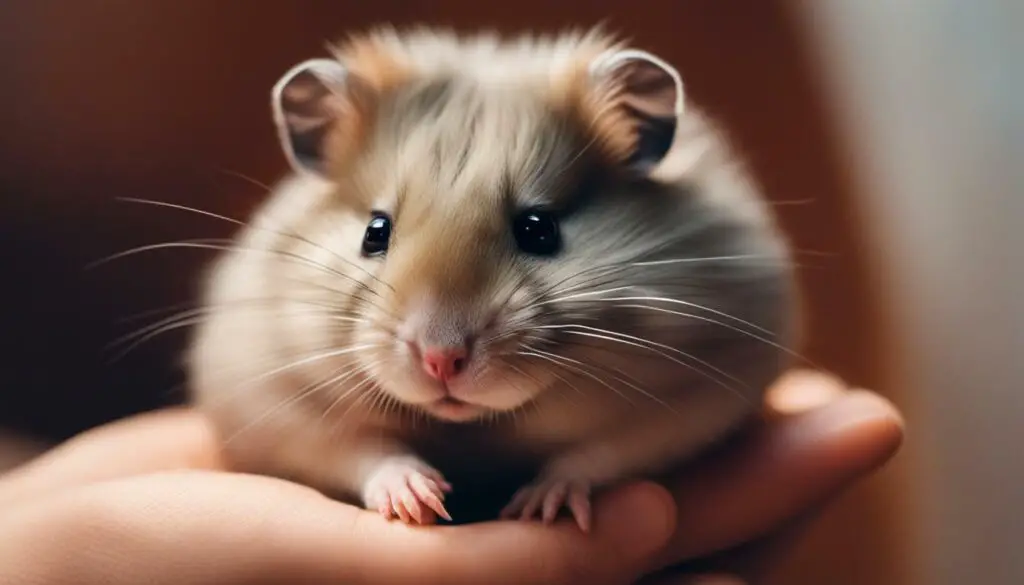
Keep in mind that not all hamsters will enjoy being petted, and that’s perfectly okay. If your hamster shows signs of discomfort, such as biting, hissing, or trying to escape, it’s crucial to respect their boundaries and give them space. Some hamsters may simply prefer minimal physical interaction and feel more comfortable observing from a distance.
Building a trusting and positive bond with your hamster takes time and patience. By understanding and respecting their individual petting preferences, you can create an environment that promotes their well-being and happiness. Remember, each hamster is unique, so it’s essential to tailor your approach to their specific needs and comfort levels.
The Benefits of Petting Your Hamster
Petting your hamster offers several benefits beyond mere physical contact. Not only does it provide a way to bond and build trust with your furry friend, but it also offers mental stimulation and can contribute to their overall well-being.
Hamsters are social creatures, and by engaging in gentle petting sessions, you are fulfilling their need for social interaction. This helps prevent feelings of loneliness and boredom, which can lead to stress and behavioral issues. Regular petting sessions can help keep your hamster happy and content.
Furthermore, petting your hamster stimulates their natural grooming instincts. When you stroke their fur, you are mimicking the grooming behavior of their companions in the wild. This can help keep their coat clean, healthy, and free from tangles. It also provides a sensory experience for them, enhancing their overall sense of well-being.
Additionally, petting your hamster can have a calming effect on both you and your pet. The rhythmic motion of your gentle strokes can help reduce anxiety and promote relaxation for both of you. It’s a wonderful way to unwind after a long day and create a positive and peaceful atmosphere.
“Petting your hamster can have a positive impact on their overall well-being and strengthen the bond between you and your furry friend.”
Remember, each hamster is unique and may have different preferences when it comes to petting. Pay attention to their reactions and adjust your approach accordingly. Some hamsters may prefer shorter sessions, while others may enjoy longer petting sessions. It’s important to respect their boundaries and always be gentle and patient when interacting with them.
Table: Hamster Interaction Tips
| Interaction Tip | Description |
|---|---|
| Observe body language | Watch for signs of enjoyment or discomfort during petting sessions. |
| Use gentle strokes | Run your fingers lightly over your hamster’s back to avoid causing any discomfort. |
| Respect their boundaries | If your hamster shows signs of not enjoying petting, give them space and try again later. |
| Be consistent | Establish a routine for petting sessions to help your hamster feel secure and comfortable. |
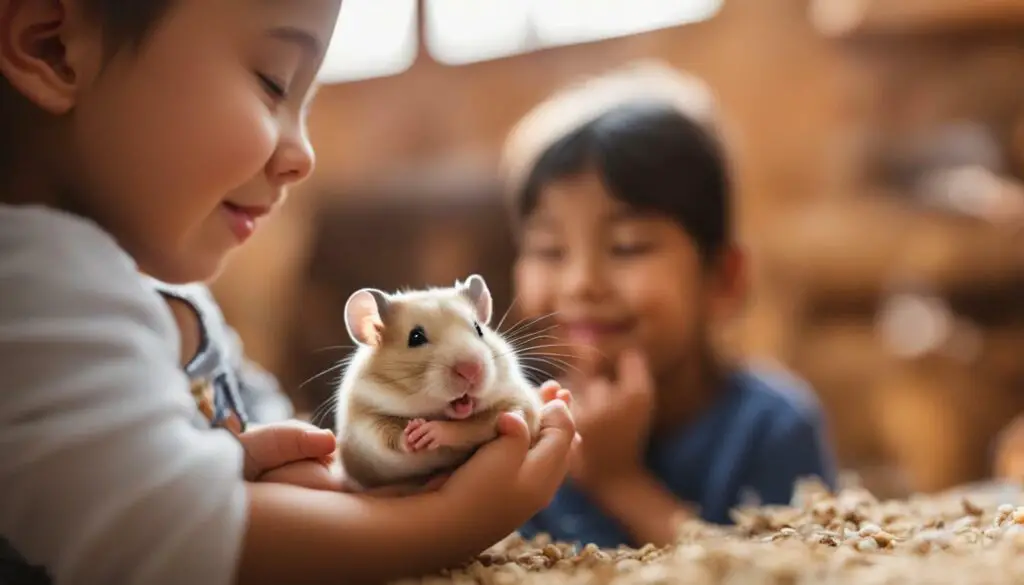
In conclusion, petting your hamster can have a positive impact on their overall well-being and strengthen the bond between you and your furry friend. It provides them with social interaction, mental stimulation, and a sense of comfort. Remember to always be gentle, observe their body language, and respect their individual preferences. By creating a positive petting experience, you are creating a happy and fulfilling environment for your hamster.
Creating a Positive Petting Experience for Your Hamster
Ensuring a positive petting experience is crucial for your hamster’s well-being and the strength of your bond. Hamsters, like humans, have unique preferences when it comes to interaction, and it’s important to respect their boundaries and cater to their individual needs. Here are some tips to help you create a positive petting experience for your furry friend:
- Choose the right time for petting: Hamsters are most active during the evening and nighttime hours, so it’s best to choose a time when they are fully awake and alert. Avoid disturbing them during their sleep or rest periods to prevent any unnecessary stress.
- Approach your hamster calmly: When you’re ready to pet your hamster, approach them gently and speak to them in a soft and soothing tone. Sudden movements or loud noises can startle them and make them feel anxious or scared.
- Use the proper technique: As mentioned earlier, cup your hamster in the cradle of your hand and run your fingers down their back with light strokes. Avoid touching their sensitive areas, such as their face, ears, or tail, as this can make them uncomfortable.
- Watch for signs of enjoyment: Pay close attention to your hamster’s body language and vocalizations during the petting session. If they chirp, have relaxed facial features, and show a relaxed body posture, it’s a clear sign that they are enjoying the interaction.
- End on a positive note: It’s important to end the petting session on a positive note. Slowly remove your hand and give your hamster some space. You can offer them a small treat or praise them gently to reinforce positive associations with the interaction.
Remember, each hamster is unique, and what works for one may not work for another. Pay attention to your pet’s preferences and adjust your approach accordingly. Building trust and a strong bond takes time, so be patient and allow your hamster to set the pace. With time and consistency, you’ll create a positive petting experience that benefits both you and your furry companion.
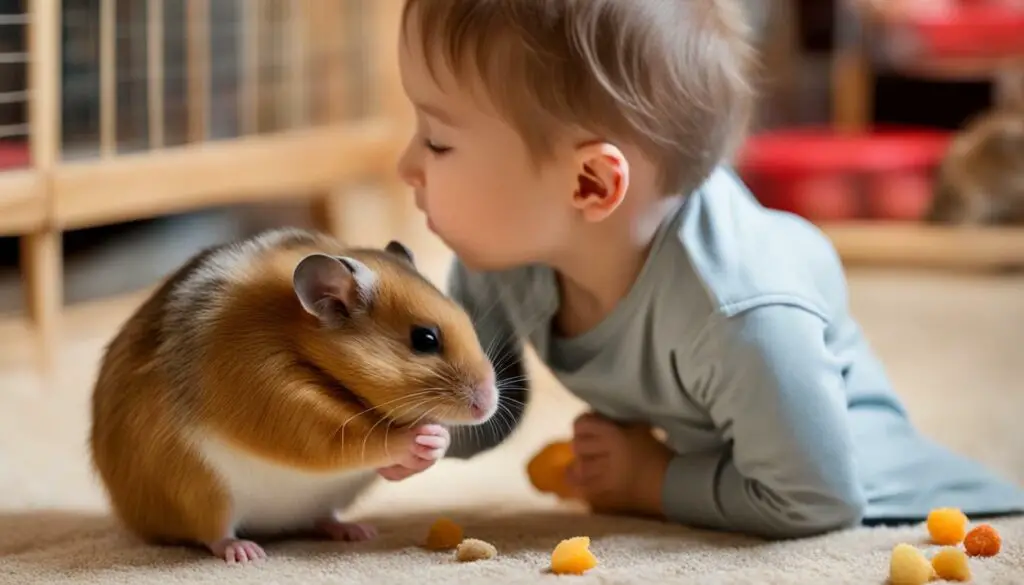
Conclusion
Building a strong bond with your hamster through petting and interaction requires patience, observation, and respect for their individual preferences. Hamsters generally enjoy being petted, but it’s important to know how and when to pet them. Like humans, hamsters have specific times and ways they prefer to be touched.
The proper way to pet a hamster is to cup them in the cradle of your hand and run your fingers down their back with light strokes. Pay attention to their body language and watch for signs that they enjoy the petting, such as chirping, relaxed facial features, and a relaxed body posture.
However, it’s crucial to remember that not all hamsters like to be petted. It’s important to respect their boundaries and be mindful of their signals. If a hamster shows signs of discomfort, such as hissing, biting, or running away, it’s best to give them space and not force interaction.
When introducing a new hamster to the idea of being petted, take it slow and be patient. Building trust and a bond takes time, and each hamster is unique in their preferences. Observe their cues and gradually increase the level of petting, always paying attention to their comfort level.
Petting and interacting with your hamster not only strengthens the bond between you, but it also provides mental stimulation for them. It’s a rewarding experience that can enhance their overall well-being and happiness. Remember to create a positive petting experience by respecting their boundaries, being gentle, and providing a comfortable environment. By following these guidelines, you can enjoy a fulfilling and enriching relationship with your furry friend.
FAQ
Do hamsters like to be pet?
Yes, hamsters generally enjoy being petted. However, it’s important to know how and when to pet them to ensure their comfort and enjoyment.
How should I pet a hamster?
The proper way to pet a hamster is to cup them in the cradle of your hand and run your fingers down their back with light strokes.
What are the signs that a hamster enjoys being petted?
Look for signs such as chirping, relaxed facial features, and a relaxed body posture, which indicate that a hamster is enjoying the petting.
What are the signs that a hamster does not like being petted?
Signs that a hamster doesn’t like being petted include hissing, biting, and running away. It’s important to respect their boundaries and stop petting if they show these signs.
How should I introduce a new hamster to petting?
It’s important to introduce a new hamster slowly to the idea of being petted. Start by offering them treats and gradually build trust and a bond with them before attempting to pet.
How can I build trust and a bond with my hamster?
Patience is key when building trust and a bond with your hamster. Spend time near their cage, offer treats, and engage in gentle interactions to gradually build trust and a positive relationship.
Are there any individual preferences when it comes to hamster petting?
Yes, each hamster may have different preferences when it comes to petting and interaction. Pay attention to their body language and adjust your approach accordingly.
What are the benefits of petting my hamster?
Petting your hamster can strengthen the bond between you, provide mental stimulation, and contribute to their overall well-being and happiness.
How can I create a positive petting experience for my hamster?
To create a positive petting experience, ensure a calm and quiet environment, use gentle strokes, and respect your hamster’s boundaries. Pay attention to their cues and adjust your approach as needed.

